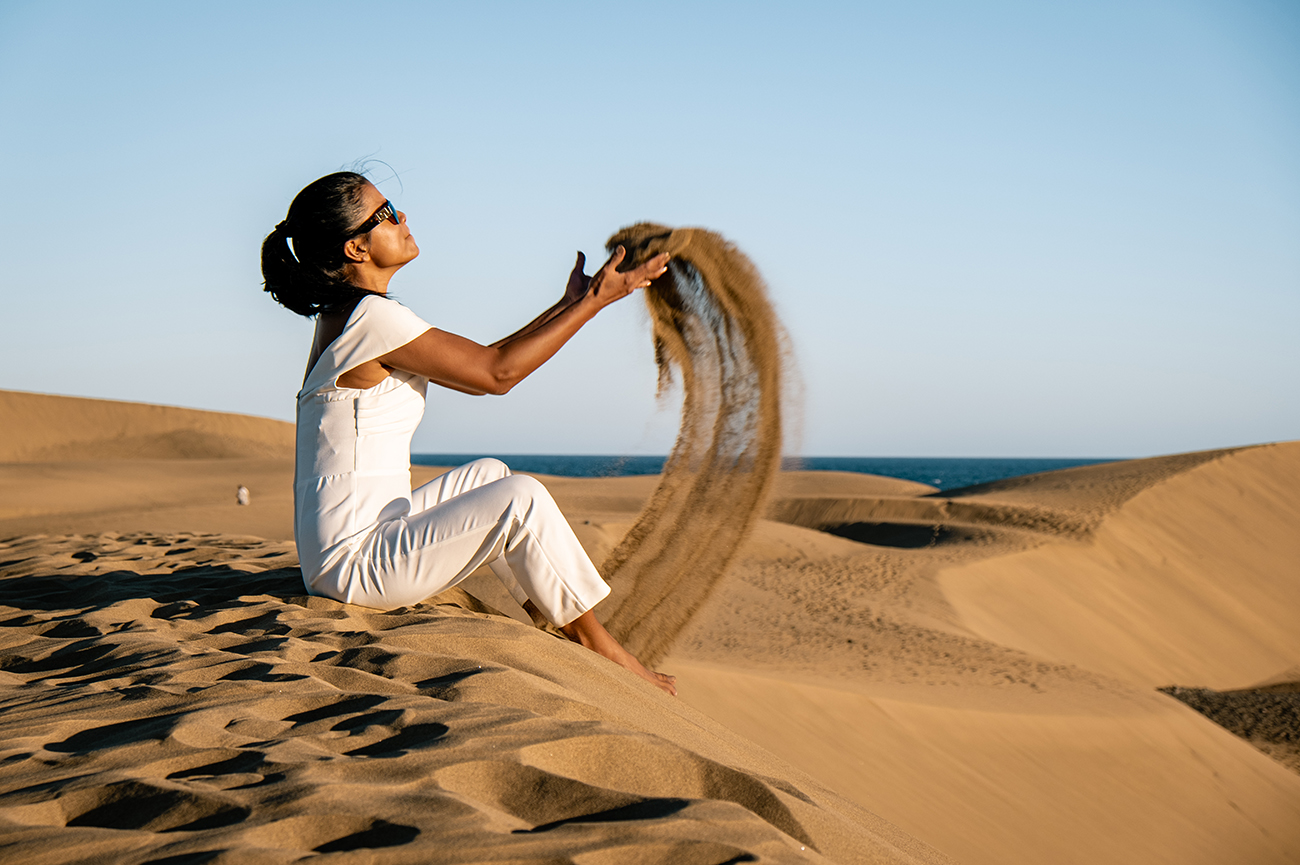Gran Canaria – The miniature continent
Gran Canaria is well-known for its beautiful beaches, which are perfect for relaxing and soaking up the sun. With over 60 kilometres of coastline, there is no shortage of options to choose from. The most popular beaches include Playa del Ingles, Maspalomas, and Puerto Rico. Playa del Ingles is the largest beach on the island and offers a range of water sports activities.
The Dunes of Maspalomas
Maspalomas is famous for its sand dunes and crystal-clear waters, while Puerto Rico is ideal for families with children due to its calm waters and numerous facilities. For those seeking a more secluded spot, Anfi del Mar offers a tranquil atmosphere with white sandy shores and turquoise blue waters.
Gran Canaria is an island that boasts a diverse array of landscapes and natural wonders, making it a must-visit destination for nature lovers. The island’s most famous natural attraction is the Maspalomas Dunes, a stunning expanse of sand dunes that stretch for miles along the southern coast. Other notable natural wonders include the Tamadaba Natural Park, which offers breath-taking views of the island’s rugged mountains and valleys, as well as the Roque Nublo rock formation, one of Gran Canarias’s most iconic landmarks.
Visitors can also explore the island’s lush forests and picturesque villages, such as Teror and Tejeda. With so much to see and do, exploring Gran Canarias’s diverse landscapes is an unforgettable experience that should not be missed.
History and Culture
Gran Canaria is a fascinating destination for those interested in history and culture. The island has a rich and diverse history dating back to prehistoric times, with influences from the indigenous Guanche people, Spanish conquistadors, and even pirates. Visitors can explore the island’s many museums, such as the Canaria Museum in Las Palmas, which showcases the history and culture of the Canary Islands.
The Old Town of Vegueta is another must-see attraction for its well-preserved colonial architecture and charming streets lined with cafes and shops. For those interested in religious history, there are numerous churches and cathedrals throughout the island, including the Basilica de la Virgen del Pino in Teror.
Local cuisine
When in Gran Canaria, it is essential to indulge in the local cuisine and traditional dishes. The island’s gastronomy is a fusion of Spanish, African, and Latin American influences that will leave your taste buds wanting more. One of the most popular dishes on the island is Papas Arrugadas, which are small salty potatoes boiled with their skin still on and served with Mojo sauce.
Another delicacy that you must try is Gofio, a flour made from roasted grains such as wheat or corn that can be used to make sweet or savoury dishes. Seafood lovers should not miss out on fresh fish prepared in various ways like Caldereta (fish stew) or grilled with garlic and parsley sauce.
Gran Canaria is a paradise for those who love outdoor activities, especially water sports and hiking. The island has an excellent year-round climate and offers visitors a wide range of options to enjoy the great outdoors. Water sports enthusiasts can indulge in activities such as surfing, windsurfing, kitesurfing, and paddleboarding. The clear waters of the Atlantic Ocean also make it possible to explore the underwater world through snorkelling or scuba diving.
Outdoor activities
For those who prefer to stay on land, Gran Canaria boasts of over 2000km of hiking trails that wind their way through stunning landscapes with breath-taking views of the sea and mountains. Visitors can also try their hand at rock climbing or mountain biking, making Gran Canaria an ideal destination for adventure seekers.
While Gran Canaria is best known for its stunning beaches and lively nightlife, the island is also home to charming towns and villages that offer a glimpse into the local way of life. One such town is Teror, located in the island’s interior. Here, visitors can wander through narrow streets lined with traditional Canarian houses and visit the impressive Basilica of Our Lady of the Pine.
Another must-visit village is Puerto de Mogan, often referred to as “Little Venice” due to its picturesque canals and colourful buildings. Visitors can stroll along the harbour or relax on one of the village’s small beaches. Other notable towns include Agaete, famous for its natural pools and hot springs, and Tejeda, which offers breath-taking views of Gran Canarias’s rugged mountain landscape.
Nightlife
Experience Gran Canarias’s vibrant nightlife scene by exploring the island’s numerous bars, clubs, and discos. The most popular areas for nightlife are Playa del Ingles and Maspalomas, where you can find a wide variety of establishments catering to different tastes. Start your evening with cocktails at one of the many beachfront bars before heading to one of the many nightclubs that stay open until dawn.
For a more laid-back atmosphere, visit Puerto de Mogan or Las Palmas de Gran Canaria, where you can enjoy live music and entertainment in a relaxed setting. Don’t miss out on the island’s famous drag shows – they are not to be missed! Whatever your preference, Gran Canaria offers plenty of options for an unforgettable night out.
Souvenirs
When visiting Gran Canaria, taking home some souvenirs is a must. The island is famous for its unique handicrafts, and there are plenty of local markets where you can find them. One of the most popular markets is the Sunday market in Teror, where you can buy everything from handmade pottery to traditional sweets. Another great option is the Puerto de Mogan market, which takes place every Friday and offers a wide range of souvenirs, including jewellery, clothes, and leather goods.
If you’re looking for something specific, head to the San Mateo farmers’ market on weekends, where you can find local produce as well as handmade baskets and other crafts.





